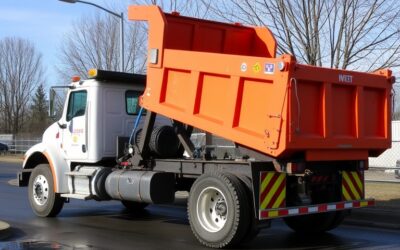Operating a dump truck has its challenges, and skipping safety measures makes things even riskier. That’s where Wink Anti-Tip devices come in. One essential tool for improving truck safety is the Wink Anti-Tip device. However, to get the most out of this advanced technology, certain precautions must be taken. Knowing what not to do is just as crucial as knowing best practices.
Dump truck drivers and operators often face a series of common pitfalls that can compromise safety. Incorrect installation, ignoring pre-trip inspections, failing to respond to alerts, and neglecting regular maintenance can all lead to dangerous situations. Understanding these common mistakes and how to avoid them can make a big difference in overall safety and efficiency.
In this article, I will discuss the critical errors to avoid when preparing and using your Wink Anti-Tip device. By steering clear of these missteps, you can ensure that your dump truck operates smoothly and safely, keeping both the driver and other road users out of harm’s way.
Incorrect Installation and Setup
Getting the installation wrong can seriously affect how well your Wink Anti-Tip device works. Ensuring a correct and secure installation is crucial for the system to function as intended. Start by following the manufacturer’s instructions closely, making sure that all components are properly mounted and connected. Any deviation from the recommended setup could lead to malfunction or inaccurate readings from the sensors.
It’s also important to perform a thorough check after installation. Verify that the device responds correctly by conducting a tilt test to see if the system issues an alert. If the device doesn’t react as expected, recheck the connections and alignment. A correctly installed Wink Anti-Tip device is your first line of defense against potential tipping hazards, so it’s worth taking the time to ensure everything is set up accurately.
Ignoring Pre-Trip Inspections
Skipping pre-trip inspections? That’s a recipe for trouble. Before every journey, it’s essential to inspect the Wink Anti-Tip device to confirm it is in proper working order. Start by examining the physical components for any signs of wear or damage. Ensure that all sensors are clean and unobstructed, as debris can interfere with their ability to detect tilt accurately.
Next, check the device’s electrical connections and make sure there are no frayed wires or loose contacts. Power up the system and perform a basic functional check by slightly tilting the truck and listening for alerts. Ignoring these simple but critical pre-trip inspections can result in undetected issues, rendering the anti-tip system ineffective when you need it the most. Regular checks not only ensure that the Wink Anti-Tip device is operational but also provide peace of mind, knowing that your vehicle is equipped to handle stability challenges on the road.
Failure to Respond to Alerts
Ignoring alerts from your Wink Anti-Tip device? That could be disastrous. The system is designed to provide timely warnings when the truck’s tilt or balance is off, allowing the driver to make immediate adjustments. When you hear or see an alert, it is crucial to take action right away. Delaying your response, even by a few seconds, could result in a tip-over, causing damage to the truck and potentially injuring the driver.
To effectively respond to alerts, drivers should be trained on the proper procedures. This includes knowing how to safely slow down, redistribute the load, or recalibrate the truck’s position. Regular training sessions can help reinforce these actions, making it second nature for drivers when an alert occurs. Responding promptly to the Wink Anti-Tip device’s alerts can greatly reduce the risk of accidents and improve overall safety on the road.
Neglecting Regular Maintenance and Updates
Skipping maintenance or updates? That’s a surefire way to shorten your Wink Anti-Tip device’s lifespan. Over time, components can wear out, and software may become outdated, reducing the system’s reliability. Establishing a routine maintenance schedule helps ensure that the device remains in top working condition. This includes cleaning the sensors, checking all electrical connections, and replacing any worn parts.
Keeping the device’s software up to date is just as important. Manufacturers often release updates that improve functionality or fix known issues. Failing to install these updates can leave the system vulnerable to malfunctions. By following a regular maintenance routine and ensuring timely software updates, you can maximize the lifespan and performance of your Wink Anti-Tip device, keeping your dump trucks safe and operational.
Final Thoughts
Avoiding these common mistakes with your Wink Anti-Tip device is key to keeping your dump truck safe and stable. Proper installation, diligent pre-trip inspections, prompt responses to alerts, and regular maintenance all play a significant role in preventing accidents and improving truck stability. Taking these steps seriously can lead to safer working conditions and more reliable dump truck operations.
For fleet managers and truck drivers looking to improve their safety measures, the Wink Anti-Tip device offers an essential layer of protection. By integrating this advanced technology into your daily routine, you can significantly reduce the risk of tip-overs and enhance the overall safety of your fleet.
Learn more about how the Wink Anti-Tip device can make a difference in your operations. Equip your trucks with the best in stability technology today!





